14/8/1887 - 10/4/1937
Record updated 16-Jan-23
Kennelm Lee Guinness was a member of the famous brewing family. He was also the inventor of the KLG spark plug. He started racing as riding mechanic for his brother Algernon in a Darracqs and went on to be an accomplished driver in his own right.
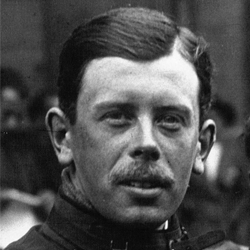
Kenelm Lee Guinness, part of the Guinness brewing family and developer of the KLG spark plug.
Kenelm Lee Guinness, better know as Bill to his friends, studied at Cambridge University. While still a student, he had acted as riding mechanic for his older brother, Sir Algernon Guinness. When he left Cambridge, Kenelm took up racing on his own account, finding a home for his racing cars in some outbuildings at an old disused pub called 'The Bald Faced Stag' in Putney Lane on the London to Portsmouth road.
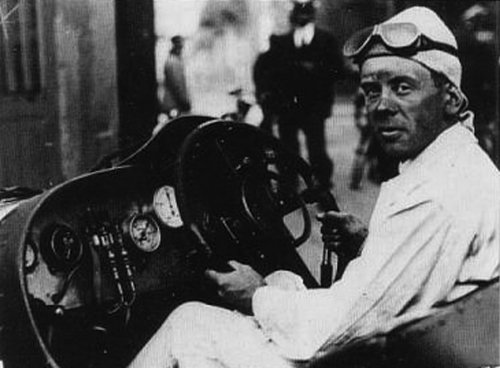
Unlike his brother Algy, who drove by the seat of his pants, Bill studied the circuits and techniques of racing to get the best results possible. And, with his mechanical empathy, he drove to finish. A bundle of nerves before a race, he hated talking to anyone and, if he happened to mislay his lucky white woolen hat, it was best to stay well clear. He was shy but always polite, even to foreigners who in general he didn't take kindly to.
Bill's first major race was in 1907 at the III Tourist Trophy on the Isle of Man, unfortunately he damaged the rear axle after 2 laps and was forced to retire. He drove a Darracq and his involvement with them, and the closely related Sunbeam and Talbot marques, continued throughout his career.
In 1912 at the Isle of Man Tourist Trophy Race, Kenelm became so frustrated with his spark plugs that he set about making a better performing plug. he began to experiment at The Bald Faced Stag and tried other materials rather than the porcelain, which was used for insulating spark plugs at the time. His solution was to use Mica and he proceeded to make a small batch of mica-insulated plugs. The results were highly satisfactory and soon his racing friends were asking him to produce more for their own use.
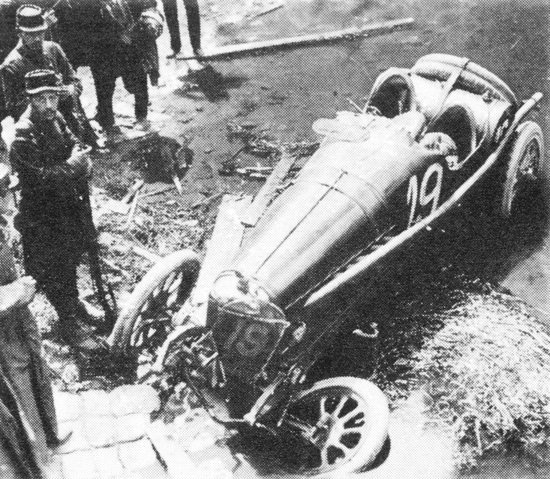
He entered the 1913 XIII Grand Prix de l'A.C.F. (French Grand Prix) in his Sunbeam but crashed on the 15th lap, however he did finish third in the VII Coupe des Voiturette at Boulogne in September.
In 1914 the Tourist Trophy was run over two days in June, with eight laps each day, giving a total of 600 miles. After the first day Kenelm, in his Sunbeam, was leading his brother Algy by just over three minutes in a time of 5hr 15min 47sec Sunbeam. The next day KLG held on to the lead while Algy dropped back. Kenelm won in a time of 10:37.49 and an average speed of 56.44 mph. Later in July he again failed to finish in the XIV Grand Prix de l'Automobile Club de France, this time his race ended on lap 9 with engine problems.
Meanwhile the production of KLG Plugs had taken off and KLG moved into large-scale production. Special plugs were designed to meet specialist requirements, in particular for the aircraft of the Royal Flying Corps, later to become the Royal Air Force. With the outbreak of the First World War, Kenelm joined the Royal Navy, but was asked to resign in order to concentrate on the production of plugs for the armed services.
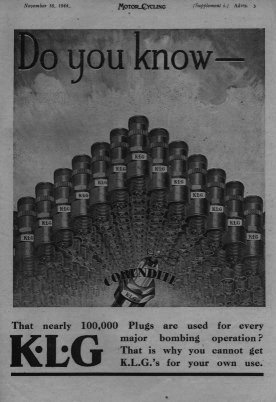
By the end of the war, KLG plugs were famous among aviators throughout the world and the production lines at The Bald Faced Stag took the form of a modern factory employing 1,500 workers located on the Portsmouth Road immediately adjacent to the cemetery where Dick Seaman was buried. It was a fine Art Deco building and really should have been preserved, but sadly it was demolished and replaced by large Asda supermarket.
From 1919 until the outbreak of the WWII, KLG spark plugs were used in almost every motoring, motorcycling or flying achievement of note, and several special engines and two complete record breaking cars were produced in the garages at the Putney factory. The cars were Sir Henry Segrave's 'Golden Arrow' and Sir Malcolm Campbell's 'Bluebird', both of which at one time held the World Land Speed Record. In 1919 Kenelm sold the world distribution rights to S.Smith and Sons (M.A.) Ltd and in 1927 he sold up completely to Smiths but stayed on as a consultant.
In 1919 he bought a boat called the Samuel Green. Originally built for the Admiralty as a minesweeper but, as war was over, she had been fitted out as a fishing trawler in anticipation of being taken up by commercial interests. The Samuel Green was re-named Ocean Rover and was converted into a private steam yacht. He had all the fishing equipment removed and created suitable accommodation for him and his guests. The original Fish Hold and Ice Room were adapted to carry racing cars, as it was considered much more practical to transport the racing cars from the U.K. to the South of France or Italy by ship than drive though Europe. Strangely, whilst the Ocean Rover never sailed under the White Ensign of the Royal Navy, as a yacht, all the owners up until 1939 were members of the Royal Yacht Squadron, which entitled them to fly the White Ensign.
Sunbeam was suffering financially after the First World War, partly due to the slump in the motor industry and partly because come of their military contracts were not paid. As a result the company merged with Darracq and Talbot in 1920 to form STD Motors (A slightly unfortunate acronym which stood for Sunbeam, Talbot, Darracq). Louis Hervé Coatalen had designed aircraft engines for Sunbeam during the war and he now took a seat the board of STD Motors Ltd, remaining the chief engineer of Sunbeam with a special interest in racing cars.
In 1921 Bill got a big black and white V-12 Sunbeam wound up at the Brooklands Easter meeting and put in a lap of 120.01 mph earning himself a coveted Brooklands 120 mph badge. In the Autumn of 1921 Bill was timed down the Railway Straight at 135 mph, entering the finishing straight at 140 mph. KLG was awarded a cup by the BARC for his achievement and for running a truly thrilling race against a very fast Vauxhall and that infamous old Lorraine Dietrich "Vieux Charles Trois" which Malcolm Campbell had managed to retrieve from France after the Great War.
That year the Automobile Club de France staged its first post-war Grand Prix at Le Mans in July. There were only 19 entrants including 7 from the STD. 3 Talbot Darracqs to be built in France, as well as 2 Sunbeams and 2 Talbots to be built in the Experimental Department at the Moorfields Works, along the lines of Coatalen’s new 3 litre, 8 cylinder car.
By mid June the cars were still not ready and Coatalen ordered that none of the seven STD cars should enter the race, even though they had cost around £50,000 to build. Segrave and KLG, who were due to drive the Talbots, rushed to Wolverhampton from Paris to try and change Coatalen’s mind. Meanwhile André Boillot, who had been practicing at Le Mans with one of the Talbot Darracqs refused to return his car to the factory. Coatalen relented and allowed the two Talbots and two of the Talbot Darracqs to compete. After a week’s hard work Segrave and Guinness got their cars.
Unfortunately both Segrave and Guinness suffered from tyre problems during the race and both cars performed badly. Segrave had to retime the ignition on his car when a set-screw came loose and Guinness had to fabricate a wooden plug when the tap on his petrol filter broke off. A stone punctured Segrave’s petrol tank and the hole had to be plugged with cotton waste. Segrave’s car finished the race in 9th only running on six cylinders, while Bill faired only slightly better finishing 8th. The cars were immediately returned to Wolverhampton and rebuilt.
In September KLG raced at the IX Coupe des Voiturettes at Le Mans finishing second and in November at Brooklands for the Junior Car Club 200 he once again finished second rounding out a successful year.
When the RAC set a date for the 1922 TT race on the Isle of Man, 3 Sunbeams were entered to be driven by Kenelm Lee Guinness, who had won there in 1914, Henry Segrave, and Jean Chassagne. However a slipping clutch prevented Bill from starting however he managed to fix the problem and later the same day his brother took victory in the International "1500" Trophy.
New 2 litre, 4 cylinder cars were built in readiness for the 1922 XVI Grand Prix de l'A.C.F. (French Grand Prix) at Strasbourg in July. KLG failed to finish when an inlet valve stem broke on lap 5. However he was back in August with a win at the II Junior Car Club "200" at Brooklands, setting the fastest lap at 1m 44.0 (154.14 kph). A win in September at the X Coupe des Voiturettes with the Talbot-Darracq was followed by another at the II Gran Premio do Penya Rhin in November.
On the 16th May 1922 KLG made a few high speed practice runs in the 18 litre, 350hp. ‘V12’ aero engined Sunbeam 'Manitou' on the Railway Straight at Brooklands which, according to friends who were timing him by hand, saw him reach speeds of 144 mph for the half mile. The following day was greeted by gale force winds and Kenelm realised there was little point in trying for the record but by 5pm the wind had eased and he took to the track. After a few warming-up laps he made his first runs in a clockwise direction to gain a slight advantage from the wind. He recorded a speed of 140.51 mph for the flying half mile, a record that stood at Brooklands for more than ten years. He then made the distances in an anti clockwise direction. His best speed over the Kilometer was 137.15 giving an average for both directions of 133.75
His 137.15 mph flying kilometer record stood unbeaten for seven years. His 133.75mph (215.24kph) set a new Land Speed Record, the first that was officially timed over two runs, one in each direction to alleviate favours of wind or gradient. It was the last time a World Land Speed Record would be set on a closed circuit. It was in this car that he went on to win the 1922 Duke of York race with a fastest lap of 122.67 m.p.h. This car was acquired by Malcolm Campbell in 1923 and became his first 'Bluebird' Land Speed Record Car.
He finished a fine 4th in the XVII Grand Prix de l'A.C.F. in the Sunbeam in 1923 after a difficult race. Up against the faster FIATs, Bill was given the task of starting fast to try to push the little Italian cars and get them to break. For the first eight laps he was in second, right on the tail of Borodino. Then Borodino's car faltered and retired and Bill took the lead. The other FIATs upped their pace and by now all was not well with the Sunbeam. By half distance KLG had dropped back to third. Then the FIAT of Giaccone then dropped out, leaving the FIAT of Salamono to hold off the Sunbeams of Divo and Seagrave. Bill redoubled his efforts and retook Seagrave for third but then encountered more trouble. Seagrave retook him and went on to take the win. Bill was still second but then stalled on a sharp corner and, while he tried to restart, both Albert Divo (Sunbeam) and Ernest Friderich (Bugatti) went passed. Bill and his mechanic eventually got the Sunbeam going and came home two minutes later in fourth place. This was the first win for a British car in the Grand Prix.
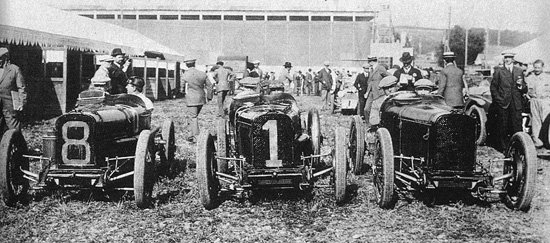
The Sunbeam Team before the 1924 GP de l'ACF at Lyon. KLG on the left, Seagrave in the denter and Dario Resta on the right.
He won the I Grand Prix de Suisse Voiturette race in Geneva with a Talbot 70 on the 15 June 1924 and in September he was due to drive a Sunbeam with Bill Perkins as his riding mechanic in the Gran Premio de San Sebastian on the Circuit de Lafarge. However on the 3rd of the month Perkins was at Brooklands assisting Dario Resta in his attack of the International Class E (2-litre) world record when they crashed. Resta was killed and Perkins suffered serious injuries that left him unable to take part in the Spanish race, thus Sunbeam brought in Thomas Barrett to replace him.

During the race, on lap 11, the car struck a rut in a corner near Aldeamuro and slid off the wet road crashing into the bank on the left. The Sunbeam rolled three times and Guinness and Barrett were thrown out into a steep railway cutting. Barrett died instantly and Kenelm suffered head and limb injuries that ended his racing career. Following the accident the rules were changed and riding mechanics were banned. Thomas Barrett thus became the last riding mechanic to be killed in a competition.
This spelt the end of his driving although he did lend a hand to Henry Segrave in America for the 200 m.p.h. record in the big red twin-engined Sunbeam which now resides at Beaulieu.
The Ocean Rover was sold to the Duke of Leeds of Hornby Castle in 1924 and her name was changed to Aries. In 1926 she sailed to the Cocos Islands on a treasure hunting trip with Kenelm and his friend Malcolm Campbell on boar
Sadly Kenelm never really recovered from the crash at San Sebastian and on Saturday April 10th 1937, he was found dead in a bedroom at his home at Melbury, Kingston Hill, Kingston-on-Thames, having apparently gassed himself. He was buried at Putney Vale Cemetery on April 14th.
At the inquest his brother Sir Algernon testified that he had become increasingly mentally unstable. KLG's doctor further explained that he had suffered from delusions, which had necessitated him being admitted to a nursing home. Sir Algy produced a sealed letter, which he had received that morning via KLG's executor, which the coroner read and offered his opinion that it indicated the probability of suicide. The doctor's opinion was that KLG had been better in recent weeks and that the suicide was a "sudden, impulsive act". Verdict: Suicide while of unsound mind.
historicracing.com
POPULAR DRIVERS FROM IRL
Kenelm Lee Guinness
Dave Kennedy
Tommy Byrne
Eddie Irvine
Joe Quinn
Derek Daly
Hugh Hamilton
Joe Kelly
Damien Magee
Eddie Jordan